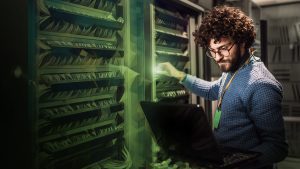According to a 2020 U.N. Global Compact Report, only 39% of the organizations surveyed believe they have sustainability targets in place that are ambitious enough to meet the U.N.’s goals for sustainable development within 10 years. As industrial stakeholders approach 2030, many organizations are realizing that they need to alter the status quo, think differently, and inspire change through accelerated digital transformation efforts.
In addition, by 2030, millennials will control most of the world’s wealth. That change will represent a transfer of about $30 trillion in assets. This new generation grew up with a keen desire to reduce carbon emissions and to make more sustainable use of the planet’s resources.

For many manufacturers, the consequences of inaction (e.g., loss of business, eroded competitiveness, regulatory fines) are too painful. The dual influence of both regulatory statutes and the handover of wealth to millennials will require that industrial organizations leverage digital transformation to achieve sustainability targets.
The challenge is equivalent to the driver of a car who, today, needs 40 liters (10 gallons) of gas to travel 320 kilometers (200 miles) and who will need to travel that same distance on only 11 liters (3 gallons) of gas in the future. It seems like an intractable dilemma.
Fortunately, the world does not stand still, particularly in technological innovation. Over time, the vehicle design will change to make the car more efficient and new fuel sources will likely provide greater propulsion while requiring smaller quantities of fuel. However, the driver himself also must change his mindset to seek out and incorporate a better solution.
How digital transformation improves sustainability performance
Digital transformation converges with sustainability goals in four important areas: energy conservation, process reengineering, data capture and analysis, and engagement of people. Generating formal plans to address these four vectors can help provide the roadmap needed for attaining aggressive sustainability targets while improving the competitiveness of the overall business.
Whether you’re thinking about, planning for or being in the middle of a digital transformation, let us help you. Book a complimentary 60-minute chat with our transformation expert!
Here’s how digital transformation can work to drive sustainability:
#1: Lower energy use
Energy consumption reduction strategies can range from implementing new ways to buy energy (e.g., leveraging renewable power purchase agreements to better control the cost of clean energy sources to run operations), to new ways of physically sourcing energy (looking to microgrids that enable higher resilience as well as greener use of energy supply), to more practical ways of consuming energy (high-efficiency heaters, compressors, pumps, motors, drives). A Schneider Electric facility in Singapore, for example, which has deployed similar energy consumption reduction strategies, is consuming seven times less energy than a nearby comparable customer facility that is just now beginning to launch digitized energy-saving initiatives.
#2: Improved process sustainability
Over the last 40 years, many industrial organizations did not pay close attention to how much energy their individual internal manufacturing processes were consuming. In many of today’s plants, the current high-carbon-footprint processes in place reflect that reality. Now, each of these processes must be examined from a sustainability perspective.
Questions such as
- Is waste being decreased?
- Are product movements minimized?
- Are the right quantities of goods being produced to address demand?
must be asked and addressed. Several years ago, these questions were difficult to answer because of a lack of visibility across the various operational silos. Now digitization makes it both affordable and possible to find answers and to apply fixes.
The World Economic Forum expects that a more sustainable, circular economy could be worth $1 trillion worldwide by 2025. As green products continue to gain steam, manufacturers will more closely embrace approaches such as “embedded sustainability” – the incorporation of environmental, health, and social value into core business activities with no trade-off in price or quality.
Achieving such a goal will require discipline and deliberate actions in both Scope 1 (direct emissions from sources the organization owns or has control over), Scope 2 (indirect GHG emissions associated with the purchase of electricity, steam, heat, or cooling, and Scope 3 (emissions related to supply chains) types of emissions.
To execute such an evolution, the organizational mindset has to change. For example, instead of an operator asking a manager for more budget to fix an existing process, that request for budget should instead focus on testing new “out of the box” approaches for creating a more holistic, sustainable process.
#3: More visibility through data and analysis
Examining an industrial organization through the lens of sustainability requires a closer look, not at the plant assets themselves, but at the function of those assets. Digital transformation allows a deeper view of how core assets are behaving. Rather than determining whether a motor is working or not, the deeper layer of data capture and analysis allows for a close look at how performance is optimized. By knowing how often a particular motor stops or starts or why a certain valve opens and closes, an operator can execute more detailed adjustments. For example, instead of having a motor run 100% of the time because that’s how it has always been done, perhaps the data justifies running that motor only 50% of the time, without significantly reducing process output and quality.
Data and analysis also become a critical cornerstone for exchanging information between manufacturers and their suppliers. In the case of Schneider Electric, suppliers are required to provide information that helps Schneider Electric manufacturing to be more efficient in planning, in waste reduction, and in energy efficiency. Schneider Electric also provides suppliers with the information they need to better control their own inventories. These types of digitized exchanges help assure that all parts of the supply chain are working together in a fashion that bolsters sustainability on each side.
#4 Accelerated situational awareness and engagement of people
New technology, greater efficiency, smarter alarms, and energy management are all key elements to improving sustainability. However, the question we’re left asking is what can we (the people) do? As we have seen with safety awareness and cyber security, the breakthrough really happened once organizational awareness campaigns were launched. The result of these campaigns meant that people took a vested interest in the betterment of their organization and became part of the solution. This concurrently meant that organizational impact was much greater. The more people are part of the solution, the closer we become to balancing organizational alignment between technology, processes, and people.
An evolution, not a revolution
The ability to convert digital transformation initiatives into tangible sustainability benefits takes time and is influenced by mindset as much as it is by technological innovation. The experience can be compared to someone who is learning to drive a car for the first time. As a seasoned driver, the exercise of opening the door and driving the car is trivial. To a new 18-year-old driver, the experience is much different. Hearing, seeing, braking, accelerating, and steering all seem to be happening simultaneously and the experience can be exhausting.
Given the complexity of digital transformation and related sustainability projects, no one company can do it alone. A manufacturer’s ecosystem of partners can greatly facilitate the process. Schneider Electric has invested significant time and conducted the due diligence of integrating and aligning industrial processes with data capture and analysis. This saves enterprises millions of dollars in investment cost and shortens time-to-market by months or even years ̶ all while reducing CO2 emissions. Read the Schneider Electric Digital Transformation Benefit Report, 2021.
Take the next step
To learn how your company can embark on a journey that embraces true digital transformation, contact Rik De Smet.
CNN Indonesia published a Digital Transformation article co-authored by Rik and Farid Belbouab, CEO of shipping company Meratus. Read the English version here.



